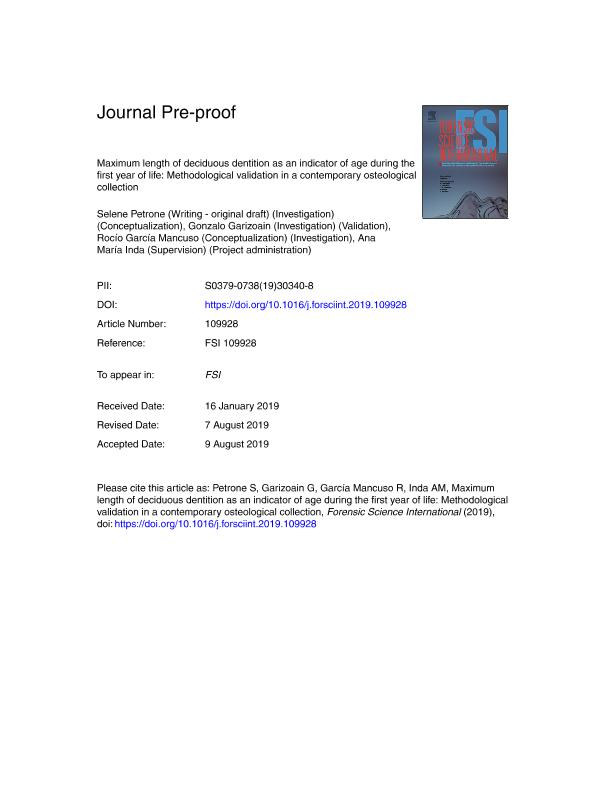Mostrar el registro sencillo del ítem
dc.contributor.author
Petrone, Selene

dc.contributor.author
Garizoain, Gonzalo

dc.contributor.author
Garcia Mancuso, Rocio

dc.contributor.author
Inda, Ana María

dc.date.available
2021-03-11T19:35:40Z
dc.date.issued
2019-08
dc.identifier.citation
Petrone, Selene; Garizoain, Gonzalo; Garcia Mancuso, Rocio; Inda, Ana María; Maximum length of deciduous dentition as an indicator of age during the first year of life: Methodological validation in a contemporary osteological collection; Elsevier Ireland; Forensic Science International; 303; 109928; 8-2019; 1-30
dc.identifier.issn
0379-0738
dc.identifier.uri
http://hdl.handle.net/11336/128125
dc.description.abstract
Out of all the available methods for estimating age at death from immature human skeletal remains, those based on odontometric variables of deciduous dentition have proved to be one of the most accurate. The development of odontometric methods has been improved through the creation of documented human osteological collections, allowing their validation in different populations. The present study aims to test the regression equations for age estimation proposed by Liversidge et al. 1993, Irurita Olivares et al. 2014, and Cardoso et al. 2019, on the basis of the maximum length of deciduous teeth in an Argentinian sample of 35 infants of known age at death. The results showed that the absolute mean difference between estimated and chronological age was 5.76 ± 6.33 weeks for Liversidge's method, 5.71 ± 6.41 weeks for Irurita Olivares's method, and 6.79 ± 5.80 for Cardoso's method. It was also found that, for Liversidge's method, the canines provided the most accurate and the least biased estimations. For Irurita Olivares's method, mandibular anterior teeth were the most accurate, while the first mandibular molars offered the least biased estimations. For Cardoso's method, the canines presented the most accurate estimations, while the lateral incisors the least biased ones. Finally, 95% confidence intervals of estimated ages were calculated for each method, finding that Irurita Olivares's method provided the most reliable age estimations when using mandibular central incisors and mandibular first molars.
dc.format
application/pdf
dc.language.iso
eng
dc.publisher
Elsevier Ireland

dc.rights
info:eu-repo/semantics/openAccess
dc.rights.uri
https://creativecommons.org/licenses/by-nc-sa/2.5/ar/
dc.subject
AGE ESTIMATION
dc.subject
DECIDUOUS DENTITION
dc.subject
FORENSIC ANTHROPOLOGY POPULATION DATA
dc.subject
MAXIMUM LENGTH
dc.subject.classification
Otras Historia y Arqueología

dc.subject.classification
Historia y Arqueología

dc.subject.classification
HUMANIDADES

dc.title
Maximum length of deciduous dentition as an indicator of age during the first year of life: Methodological validation in a contemporary osteological collection
dc.type
info:eu-repo/semantics/article
dc.type
info:ar-repo/semantics/artículo
dc.type
info:eu-repo/semantics/publishedVersion
dc.date.updated
2021-03-05T19:01:31Z
dc.journal.volume
303
dc.journal.number
109928
dc.journal.pagination
1-30
dc.journal.pais
Irlanda

dc.description.fil
Fil: Petrone, Selene. Universidad Nacional de La Plata. Facultad de Ciencias Médicas. Departamento de Ciencias Morfológicas. Cátedra de Citología y Embriología A; Argentina. Consejo Nacional de Investigaciones Científicas y Técnicas; Argentina
dc.description.fil
Fil: Garizoain, Gonzalo. Universidad Nacional de La Plata. Facultad de Ciencias Médicas. Departamento de Ciencias Morfológicas. Cátedra de Citología y Embriología A; Argentina. Consejo Nacional de Investigaciones Científicas y Técnicas; Argentina
dc.description.fil
Fil: Garcia Mancuso, Rocio. Consejo Nacional de Investigaciones Científicas y Técnicas; Argentina. Universidad Nacional de La Plata. Facultad de Ciencias Médicas. Departamento de Ciencias Morfológicas. Cátedra de Citología y Embriología A; Argentina
dc.description.fil
Fil: Inda, Ana María. Universidad Nacional de La Plata. Facultad de Ciencias Médicas. Departamento de Ciencias Morfológicas. Cátedra de Citología y Embriología A; Argentina
dc.journal.title
Forensic Science International

dc.relation.alternativeid
info:eu-repo/semantics/altIdentifier/url/https://www.sciencedirect.com/science/article/abs/pii/S0379073819303408?via%3Dihub
dc.relation.alternativeid
info:eu-repo/semantics/altIdentifier/doi/http://dx.doi.org/10.1016/j.forsciint.2019.109928
Archivos asociados
